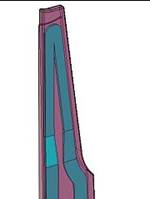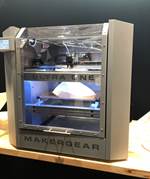Additive Manufacturing Has Found A Home in Moldmaking
Andrew Garstkiewicz, Senior AME for GE Appliances, a Haier company, reflects on 3D printing’s past and future in moldmaking.
Additive manufacturing (AM), or 3D printing, in moldmaking and molding will continue to progress as more players in the industry see results from the early adopters and gain more confidence to add it to their business strategy. Early adopters have already done groundbreaking work, driving additive material vendors to develop more and different additive material to expand uses, as well as driving the additive machine makers to listen to feedback on what has worked, what has not and what is needed to progress further. On the molding shop floor, early adopters have deduced what is required to maintain and keep additive inserts working as they were designed to do.
Conformal cooling arises quickly in conversation with molders and moldmakers when additive manufacturing is mentioned. Companies that specialize in additive-created conformal cooled inserts work with OEMs and moldmakers and can run simulation to show the before- and aftereffects of using a conformal insert. Accuracy is paramount in these analyses and has a direct bearing on ensuring heat removal to properly address pressure drops and Reynolds numbers. It is possible to design an insert that would not be useful due to a large pressure drop that minimizes turbulent flow to remove the heat.
Hybrid designs are now being seen where the base of the cooling insert is manufactured with traditional subtractive methods, and then the complex conformal areas are added on top of the base piece. This approach can allow for more acceptable pressure drops, while still providing the benefits of very localized heat removal. It can also lower costs and lead times for producing the entire insert.
In conclusion, AM in molding and moldmaking has found a home, but not all the rooms are occupied. There are many companies that have already been successful at implementing this strategy to help with productivity and costs, and there will be many more that jump on the bandwagon. It will take more time, with more case studies and some pitfall analyses to further prove out its value, but this technology is here to stay, at least until the next great advantage comes to the industry.
For More Information
GE Appliances, a Haier company / 502-452-5690 /
andrew.garstkiewicz@geappliances.com / geappliances.com
Related Content
-
3D Printing Enables Better Coolant Delivery in Milling Operations
Just like 3D printing enabled conformal cooling channels in molds, additive manufacturing is now being used to optimize coolant delivery in cutting tools.
-
Large Hybrid Steel Insert Solves Deformation, Dimensionality, Cycle Time Problems
DMLS printers using metal additive powders selected by Linear AMS to produce high-quality, accurate, consistent 3D-printed mold components with certification and traceability.
-
How to Supply Cooling to Additive Tooling
Additive tooling provides limitless options for cooling a mold’s difficult-to-cool areas.















